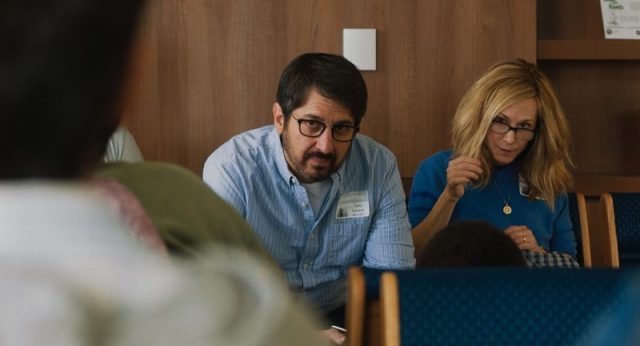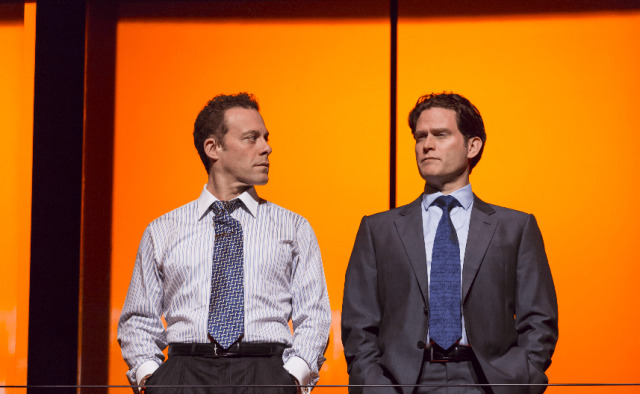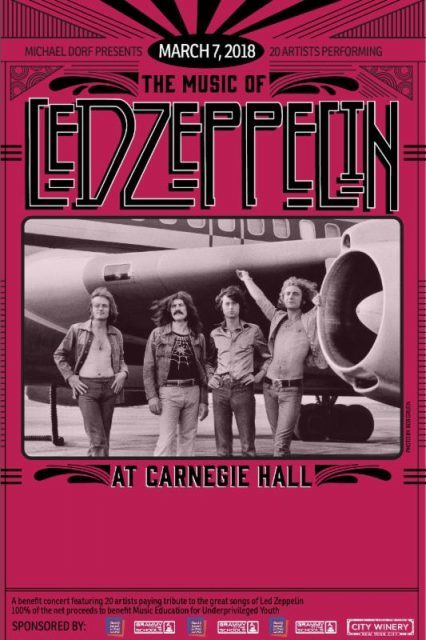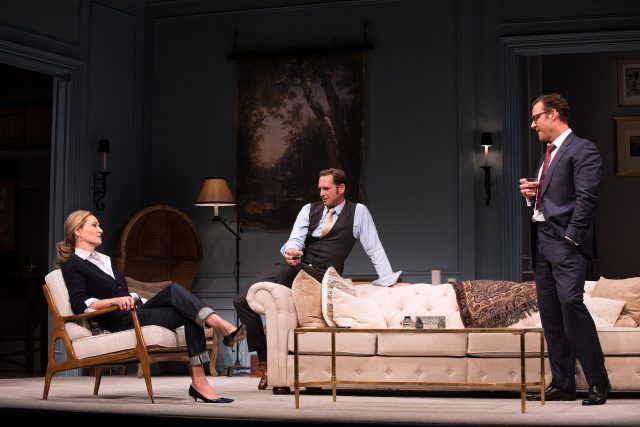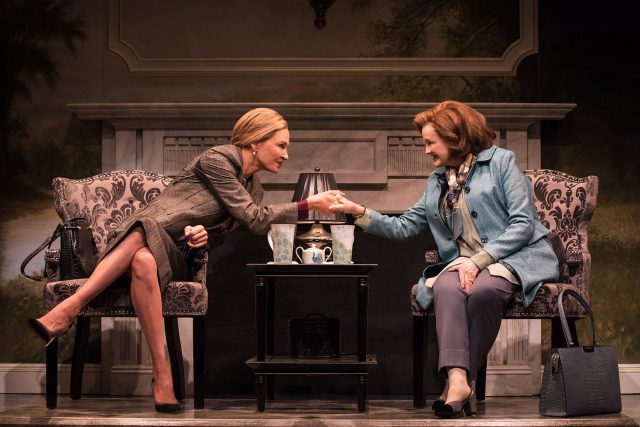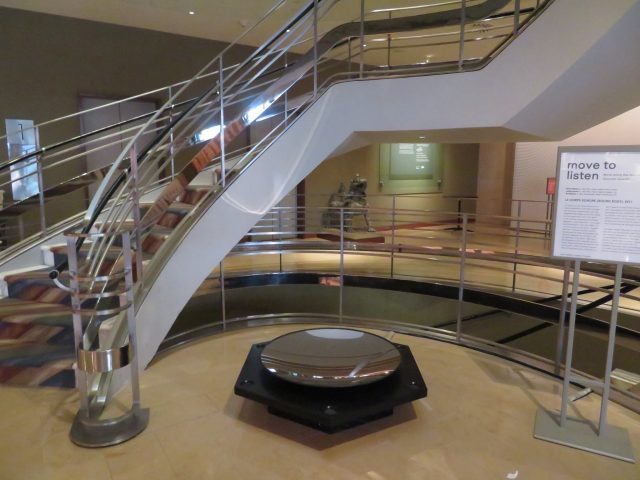
Éliane Radigue, Laetitia Sonami, and Bob Bielecki’s “Le Corps Sonore (Sound Body)” winds its way sonically up the Rubin’s spiral staircase (photo by twi-ny/mdr)
THE WORLD IS SOUND
Rubin Museum of Art
150 West 17th St. at Seventh Ave.
Wednesday – Monday through January 8, $10-$15 (free Fridays 6:00 – 10:00)
212-620-5000
rubinmuseum.org
Listen up now: There are currently two excellent interactive exhibitions in New York City dedicated to the sound of art, and the art of sound, “The World Is Sound” at the Rubin Museum of Art through January 8 and “Sonic Arcade: Shaping Space with Sound” at the Museum of Arts & Design through February 25. “If you focus your attention, you can hear inside sound, you can hear that there’s more there than just what’s on the surface. I find that kind of listening very meditative. It’s centering,” Bob Bielecki says regarding his contribution to the show at the Rubin, “. . . from a distance,” an audio installation of environmental sounds recorded in India and Nepal. Meanwhile, composer Hildegard Westerkamp, who also uses field recordings from India in her piece, “Into India,” notes, “We respond differently when we begin to listen. It can become almost a revolutionary act.” The Rubin exhibition is divided into Body, Creation, Ritual, Listening, Death & Rebirth, and OM Lab, consisting of more than seventy-five works that also incorporate touch and sight while exploring aspects of Tibetan Buddhism relating to the cycle of samsara. Walking up the spiral staircase, you’ll encounter Éliane Radigue, Laetitia Sonami, and Bielecki’s “Le Corps Sonore (Sound Body),” a site-specific sonic labyrinth that rises from a resonant bowl on the floor and reaches up to the ceiling. If you take the elevator instead, you’ll hear fifteen of the artists discussing the first sounds they can remember and the last sound they expect to hear.
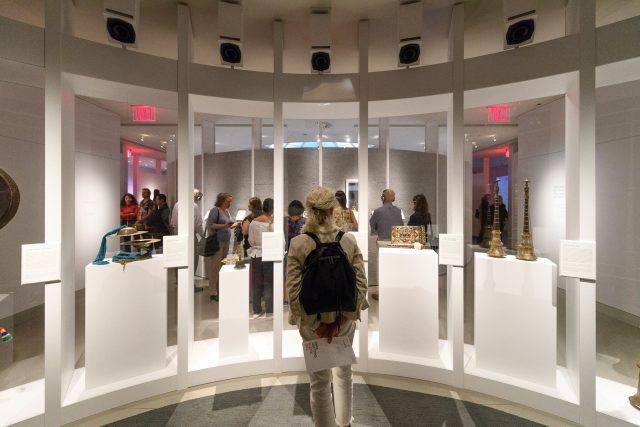
Visitors can immerse themselves in multiple ways in sound exhibit at the Rubin Museum (photo by Filip Wolak)
You need to touch the wall to hear a series of mantras that are paired with related paintings and sculptures from the Rubin collection, including the Manjushri Mantra, the Heart Sutra Mantra, and the Vajrayogini Mantra, while other works are accompanied by chants from monasteries in Nepal and India and a retreat center in upstate New York. In the OM Lab, you can hear a collective OM recorded by museum visitors this past summer, who chanted the seed syllable in a special booth. Christine Sun Kim and John Giorno team up for “Voice” (through January 14), using video, silkscreened text, and abstract, coded poetry in such works as “Words Come from Sounds” and “The Sound of Relevance.” You can hear such instruments as the dung kar (ceremonial conch trumpet), dril bu (bell), dung chen (long horn), and gya ling (oboe) if you get close to them, while you are also invited to lie down on a bench to activate Tibetan funerary text recitations. There are also such videos as Resonant Universe, Daniel Neumann’s Intermediate States, and Robert Aiki Aubrey Lowe’s Harmonic Course, which challenge the senses, while you’ll need to put on headphones to check out audio works by Jules Gimbrone, MSHR, Samita Sinha, Nathan Wooley, C. Spencer Yeh, and others. As the wall text advises, “listen with your whole body” if you want to get the full effect of the exhibition, which was curated by Risha Lee to follow the path from creation to death to rebirth. Be adventurous and follow every passageway, as the exhibit is filled with surprises around every corner. And be sure to read the first issue of the Rubin’s Spiral magazine, which delves even further into the world of sound.

Visitors activate MSHR’s “Knotted Gate Presence Weave” by walking under the arches and following the paths (photo by twi-ny/mdr)
SONIC ARCADE: SHAPING SPACE WITH SOUND
Museum of Arts & Design
2 Columbus Circle at 58th St. & Eighth Ave.
Tuesday – Sunday through February 25, $12-$16 (pay-what-you-wish Fridays 6:00 – 9:00)
212-299-7777
madmuseum.org
You can get even more involved at the Museum of Arts & Design’s “Sonic Arcade: Shaping Space with Sound,” which covers several floors as well as the stairwells and the lobby. The show focuses more on technological innovation and visceral pleasure as visitors make their way through a sonic wonderland where their touch and movement activates the works. “I was interested from an early age in the way our realities and surroundings are constructed, the way an experience is defined and placed,” Naama Tsabar says about “Propagation (Opus 3),” a large-scale wall installation that museumgoers can play by plucking vertical piano wires. She adds, “Sound and music were key players in blocking the outside world as well as in taking someone, and their surroundings, on a journey while inducing movements and interactions among humans specific to those places.” Foo/Skou’s “Format 3” takes people on a sonic journey through stairwell B, where they can perform their own score by touching sculptural squares, circles, and triangles that represent earth, water, and fire. MSHR’s “Knotted Gate Presence Weave” is a cybernetic musical composition consisting of futuristic digital-logic archways that are activated as you move through its mazelike structure, sound and light rattling through the purple space. Visitors are encouraged to remove their shoes and enjoy Studio PSK’s “Polyphonic Playground,” in which children and adults can climb ladderlike objects and ride on swings that respond to touch and movement by emitting musical sounds. One of the artists-in-residence, Stephanie Acosta, NIC Kay, or Steven Reker, is often there to perform and answer questions about the project; there will also be a guided “play time” most Thursdays at 5:00.
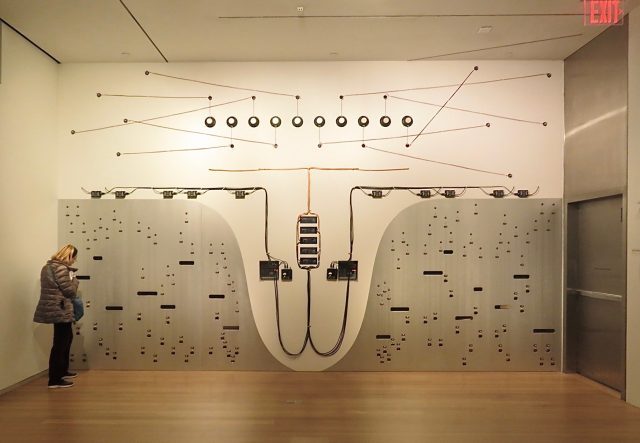
Naama Tsabar’s “Propagation (Opus 3)” offers museumgoers the chance to form their own electronic string band (photo by twi-ny/mdr)
You’ll have to pick up a transistor radio and headphone at the front desk to experience Anna Friz’s “Echophone,” one of several works curated by Jeff Kolar and his experimental radio broadcast platform known as Radius. Curator Robert Aiki Aubrey Lowe’s “Subject to Gesture” brings together interactive hand-built analog synthesizers by Emily Counts, Make Noise, and others that people can play by twisting knobs, pushing objects, and filling out a card. Julianne Swartz was inspired by the Buddhist singing bowl in creating “Sine Body,” a table occupied by translucent abstract vessels made of acoustically reflective ceramic and glass that use electronic feedback and air to emit sound with a mallet. And Christie Wright and Arjen Noordeman’s “Audiowear” display features jewelry that acts like idiophone and aerophone instruments; the necklaces and bracelets are joined by videos showing the pieces being used in concerts. In addition, Deborah Stratman’s “Hearsay” and “Siege” can be heard in the Turnstyle Underground Market in the 59th St. – Columbus Circle subway station the first seven minutes of every hour on weekdays except 8:00 – 10:00 am and 5:00 – 7:00 pm. Together, “The World Is Sound” at the Rubin and “Sonic Arcade” at MAD offer visitors the opportunity to reevaluate the potential of sound both as inner healing and pure sensory pleasure.
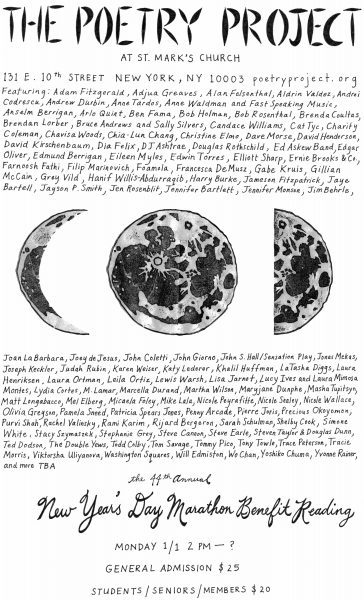

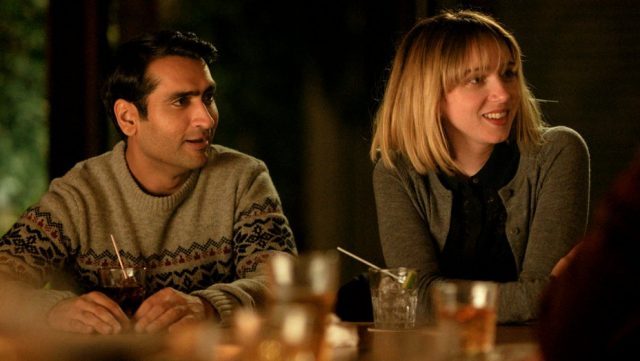
 Michael Showalter’s surprise summer hit, The Big Sick, is a heart-wrenchingly bittersweet romantic comedy loosely based on the real life of Pakistani American actor and comic Kumail Nanjiani. It would do a disservice to call the film, which was produced by Judd Apatow and Barry Mendel, a mere romcom, as it is so much more, taking on religion, assimilation, responsibility, culture, and personal identity with intelligence and wit. Kumail plays an Uber driver and stand-up comedian gigging at a Chicago club with fellow comics CJ (Bo Burnham), Mary (Aidy Bryant), and his doofy roommate, Chris (Kurt Braunohler). Kumail spends a lot of time at his parents’ suburban home, the heart of his family, where his mother, Sharmeen (Zenobia Shroff) and father, Azmat (Anupam Kher), continually invite single young Pakistani women to “drop by” to meet him, determined to arrange a proper marriage for their son. However, Kumail has started sort-of seeing a blond American woman, Emily Gardner (Zoe Kazan), after she playfully heckles him at a gig. As their relationship gets more serious, Kumail still hasn’t told his parents or his brother, Naveed (Adeel Akhtar), jeopardizing their future, but when Emily is struck by a sudden illness, Kumail reevaluates who he is and what he desires out of life. Emily’s illness also forces him to get to know her parents, Beth (Holly Hunter) and Terry (Ray Romano), who at first want nothing to do with him.
Michael Showalter’s surprise summer hit, The Big Sick, is a heart-wrenchingly bittersweet romantic comedy loosely based on the real life of Pakistani American actor and comic Kumail Nanjiani. It would do a disservice to call the film, which was produced by Judd Apatow and Barry Mendel, a mere romcom, as it is so much more, taking on religion, assimilation, responsibility, culture, and personal identity with intelligence and wit. Kumail plays an Uber driver and stand-up comedian gigging at a Chicago club with fellow comics CJ (Bo Burnham), Mary (Aidy Bryant), and his doofy roommate, Chris (Kurt Braunohler). Kumail spends a lot of time at his parents’ suburban home, the heart of his family, where his mother, Sharmeen (Zenobia Shroff) and father, Azmat (Anupam Kher), continually invite single young Pakistani women to “drop by” to meet him, determined to arrange a proper marriage for their son. However, Kumail has started sort-of seeing a blond American woman, Emily Gardner (Zoe Kazan), after she playfully heckles him at a gig. As their relationship gets more serious, Kumail still hasn’t told his parents or his brother, Naveed (Adeel Akhtar), jeopardizing their future, but when Emily is struck by a sudden illness, Kumail reevaluates who he is and what he desires out of life. Emily’s illness also forces him to get to know her parents, Beth (Holly Hunter) and Terry (Ray Romano), who at first want nothing to do with him.